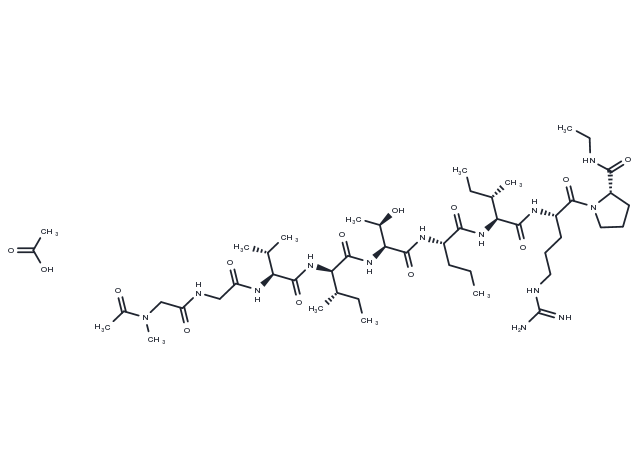keep away from moisture
Powder: -20°C for 3 years | In solvent: -80°C for 1 year

ABT-510 acetate is an endogenous anti-angiogenic TSP peptide inhibitor, a thrombospondin analog, with anti-inflammatory, anti-cancer and anti-angiogenic activity that induces apoptosis and inhibits ovarian tumor growth in an orthotopic, syngeneic model of epithelial ovarian cancer.ABT-510 acetate reduces angiogenesis and inflammatory responses in a mouse model of inflammatory bowel disease. ABT-510 acetate reduces angiogenesis and inflammation in mouse models of inflammatory bowel disease (IBD) and can be used in cancer research, particularly in epithelial ovarian cancer, as well as in inflammatory bowel disease (IBD).

| Pack Size | Availability | Price/USD | Quantity |
|---|---|---|---|
| 1 mg | In stock | $ 54.00 | |
| 5 mg | In stock | $ 128.00 | |
| 10 mg | In stock | $ 193.00 | |
| 25 mg | In stock | $ 327.00 | |
| 50 mg | In stock | $ 489.00 | |
| 100 mg | In stock | $ 713.00 |

| Description | ABT-510 acetate is an endogenous anti-angiogenic TSP peptide inhibitor, a thrombospondin analog, with anti-inflammatory, anti-cancer and anti-angiogenic activity that induces apoptosis and inhibits ovarian tumor growth in an orthotopic, syngeneic model of epithelial ovarian cancer.ABT-510 acetate reduces angiogenesis and inflammatory responses in a mouse model of inflammatory bowel disease. ABT-510 acetate reduces angiogenesis and inflammation in mouse models of inflammatory bowel disease (IBD) and can be used in cancer research, particularly in epithelial ovarian cancer, as well as in inflammatory bowel disease (IBD). |
| In vitro |
ABT-510 acetate (1, 5, 10, 20, 50 nM; 24 h) induces apoptosis in ID 8 cells and increases the incidence of apoptosis in human epithelial cancer cell lines SKOV3, OVCAR3, and CAOV3.[1] ABT-510 acetate (0-10 μM; 7 days) inhibits NO-stimulated growth and invasion of vascular cells into the extracellular matrix. ABT-510 acetate blocks tumor-driven vascular cell growth, NO-driven cGMP flux, and CD36-mediated fatty acid uptake.[3] |
| In vivo |
ABT-510 acetate (100 mg/kg; i.p.; once daily for 90 days) induces apoptosis in vivo and significantly reduces epithelial ovarian tumor size, ascites volume, and secondary lesion spread in mice.[1] ABT-510 acetate (60 mg/kg; subcutaneous osmotic minipump; once daily for 7 days) reduces angiogenesis and inflammation in a mouse model of inflammatory bowel disease.[2] |
| Synonyms | ABT 510 acetate |
| Molecular Weight | 1054.28 |
| Formula | C48H87N13O13 |
| CAS No. | 442526-87-6 |
keep away from moisture
Powder: -20°C for 3 years | In solvent: -80°C for 1 year
H2O: 90.0 mg/mL (85.4 mM), Sonication is recommended.
You can also refer to dose conversion for different animals. More
bottom
Please see Inhibitor Handling Instructions for more frequently ask questions. Topics include: how to prepare stock solutions, how to store products, and cautions on cell-based assays & animal experiments, etc.
ABT-510 acetate 442526-87-6 Apoptosis ABT-510 Acetate ABT510 Acetate ABT 510 acetate ABT 510 Acetate inhibitor inhibit
